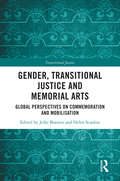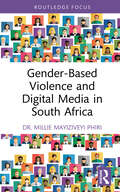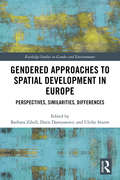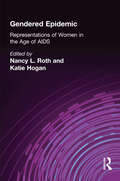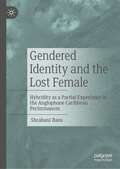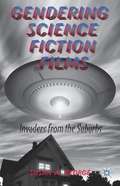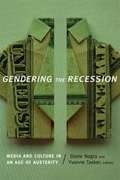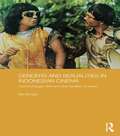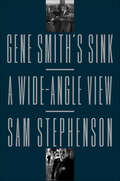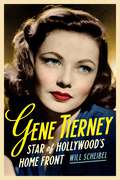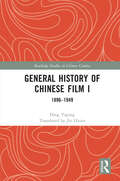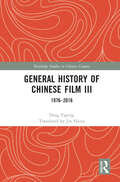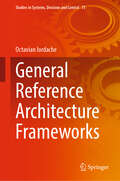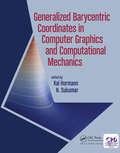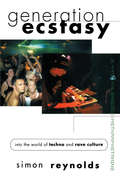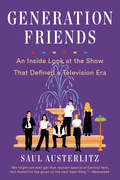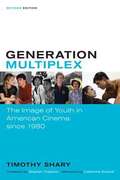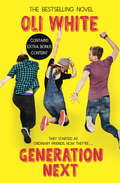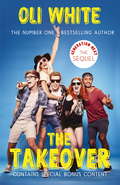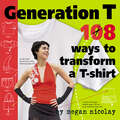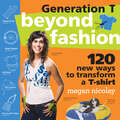- Table View
- List View
Gender, Transitional Justice and Memorial Arts: Global Perspectives on Commemoration and Mobilization
by Jelke Boesten and Helen ScanlonThis book examines the role of post-conflict memorial arts in bringing about gender justice in transitional societies. Art and post-violence memorialisation are currently widely debated. Scholars of human rights and of commemorative arts discuss the aesthetics and politics not only of sites of commemoration, but of literature, poetry, visual arts and increasingly, film and comics. Art, memory and activism are also increasingly intertwined. But within the literature around post-conflict transitional justice and critical human rights studies, there is little questioning about what memorial arts do for gender justice, how women and men are included and represented, and how this intertwines with other questions of identity and representation, such as race and ethnicity. The book brings together research from scholars around the world who are interested in the gendered dimensions of memory-making in transitional societies. Addressing a global range of cases, including genocide, authoritarianism, civil war, electoral violence and apartheid, they consider not only the gendered commemoration of past violence, but also the possibility of producing counter-narratives that unsettle and challenge established stereotypes. Aimed at those interested in the fields of transitional justice, memory studies, post-conflict peacebuilding, human rights and gender studies, this book will appeal to academics, researchers and practitioners.
Gender-Based Violence and Digital Media in South Africa (Routledge Focus on Media and Cultural Studies)
by Millie Mayiziveyi PhiriThis book presents a new paradigm for attending to gender-based violence (GBV) social media discourse among marginalised Black women in South Africa. Focusing on the intersections of television and social media, the study charts the morphing and merging of the “inside” of the soap opera and the “outside” of the real world, amid a rise in feminist social media activism. The analysis begins with coverage of gender-based violence in a long-running South African soap opera and social media discussion of these issues, in parallel with real-world events and the collective social media response. The author offers pertinent insights into audiences in sub-Saharan Africa, presenting a new feminist trajectory for women and activism in the region. Offering new insights into an important issue, this book will be of interest to scholars and students of gender, cultural studies, film studies, television studies, sociology, development studies, feminism, media, and journalism.
Gendered Approaches to Spatial Development in Europe: Perspectives, Similarities, Differences (Routledge Studies in Gender and Environments)
by Barbara Zibell Doris Damyanovic Ulrike SturmThis book explores the extent to which gendered approaches are evident and effective in spatial development in selected European countries. Beginning with an introduction to theories and concepts of gender, space and development, the book includes a brief historical review of gender in spatial planning and development throughout Europe in general, and an overview of different national frameworks in European countries, comparing legal, organisational and cultural similarities and differences. This is followed by a critical reflection on how simplifications and stereotypes of gender concepts are used in the practice of spatial development. The main part of the book offers a transnational discussion of planning practices on selected thematic topics. It starts with gender-sensitivity in urban master planning and at neighbourhood level referring to different types of planning manuals. Furthermore, the book focuses on gender-sensitive evaluation in urban planning as well as international agendas for sustainable development as a framework for a new generation of gender equality policies. The chapter authors assert that climate change, migration and austerity have threatened gender equality and therefore spatial development needs to be especially alert to gender dimensions. The editors end with an outlook and suggestions for further action and research on gender issues in spatial development. With inputs from some of Europe’s leading thinkers on gender, space and development, this volume is designed to inspire students, scholars and practitioners to reflect upon the contribution that gendered approaches can make in the various fields of spatial development and environmental planning.
Gendered Epidemic: Representations of Women in the Age of AIDS
by Nancy L. Roth Katie HoganFirst Published in 1998. Routledge is an imprint of Taylor & Francis, an informa company.
Gendered Identity and the Lost Female: Hybridity as a Partial Experience in the Anglophone Caribbean Performances
by Shrabani BasuThis book offers an exploration of the postcolonial hybrid experience in anglophone Caribbean plays and performance from a feminist perspective.In a hitherto unattempted consideration of Caribbean theatre and performance, this study of gendered identities chronicles the postcolonial hybrid experience – and how it varies in the context of questions of sex, performance and social designation. In the process, it examines the diverse performances of the anglophone Caribbean. The work includes works by Caribbean anglophone playwrights like Derek Walcott, Mustapha Matura, Michael Gikes, Dennis Scott, Trevor Rhone, Earl Lovelace and Errol John with more recent works of Pat Cumper, Rawle Gibbons and Tony Hall. The study would also engage with Carnival, calypso and chutney music, while commenting on its evolving influences over the hybrid imagination.Each section covers the dominant socio-political thematics associated with the tradition and its effect on it, followed by an analysis of contemporaneously significant literary and cultural works – plays, carnival narrative and calypso and chutney lyrics as well as the experiences of performers. From Lovelace’s fictional Jestina to the real-life Drupatee, the book critically explores the marginalization of female performances while forming a hybrid identity.
Gendering Science Fiction Films
by Susan A. GeorgeIn the 1950s, science fiction (SF) invasion films played a complicated part in both supporting and criticizing Cold War ideologies. George examines what these films reveal about the tensions in the United States at the dawn of the atomic age especially concerning gender roles and expectations. Using a cultural studies approach, she works from the assumption that "invasion" films with their "us" versus "them" nature provide important visual and verbal narratives for American citizens' trying to understand and negotiate the social and political changes that followed the allied victory in World War II. By reading these invasion narratives as performances of middle-class, primarily white Americans' excitement and anxieties about social and political issues, George shows how they often played out as another round in the battle of the sexes. This book examines the way representation in these films tap into anxieties concerning the feminine and alien other.
Gendering the Recession: Media and Culture in an Age of Austerity
by Diane Negra Yvonne TaskerThis timely, necessary collection of essays provides feminist analyses of a recession-era media culture characterized by the reemergence and refashioning of familiar gender tropes, including crisis masculinity, coping women, and postfeminist self-renewal. Interpreting media forms as diverse as reality television, financial journalism, novels, lifestyle blogs, popular cinema, and advertising, the contributors reveal gendered narratives that recur across media forms too often considered in isolation from one another. They also show how, with a few notable exceptions, recession-era popular culture promotes affective normalcy and transformative individual enterprise under duress while avoiding meaningful critique of the privileged white male or the destructive aspects of Western capitalism. By acknowledging the contradictions between political rhetoric and popular culture, and between diverse screen fantasies and lived realities, Gendering the Recession helps to make sense of our postboom cultural moment.Contributors. Sarah Banet-Weiser, Hamilton Carroll, Hannah Hamad, Anikó Imre, Suzanne Leonard, Isabel Molina-Guzmán, Sinéad Molony, Elizabeth Nathanson, Diane Negra, Tim Snelson, Yvonne Tasker, Pamela Thoma
Genders and Sexualities in Indonesian Cinema: Constructing gay, lesbi and waria identities on screen (Media, Culture and Social Change in Asia)
by Ben MurtaghIndonesia has a long and rich tradition of homosexual and transgender cultures, and the past 40 years in particular has seen an increased visibility of sexual minorities in the country, which has been reflected through film and popular culture. This book examines how representations of gay, lesbian and transgender individuals and communities have developed in Indonesian cinema during this period. The book first explores Indonesian engagement with waria (male-to-female transgender) identities and the emerging representation of gay and lesbi Indonesians during Suharto’s New Order regime (1966-98), before going on to the reimagining of these positions following the fall of the New Order, a period which saw the rebirth of the film industry with a new generation of directors, producers and actors. Using original interview research and focus groups with gay, lesbi and waria identified Indonesians, alongside the films themselves and a wealth of archival sources, the book contrasts the ways in which transgendered lives are actually lived with their representations on screen.
Gene Smith's Sink: A Wide-Angle View
by Sam StephensonAn incisive biography of the prolific photo-essayist W. Eugene SmithFamously unabashed, W. Eugene Smith was photography’s most celebrated humanist. As a photo essayist at Life magazine in the 1940s and ’50s, he established himself as an intimate chronicler of human culture. His photographs of war and disaster, villages and metropolises, doctors and midwives, revolutionized the role of images in journalism, transforming photography for decades to come.When Smith died in 1978, he left behind eighteen dollars in the bank and forty-four thousand pounds of archives. He was only fifty-nine, but he was flat worn-out. His death certificate read “stroke,” but, as was said of the immortal jazzman Charlie Parker, Smith died of “everything,” from drug and alcohol benders to weeklong work sessions with no sleep.Lured by the intoxicating trail of people that emerged from Smith’s stupefying archive, Sam Stephenson began a quest to trace his footsteps. In Gene Smith’s Sink, Stephenson merges traditional biography with rhythmic digressions to revive Smith’s life and legacy. Traveling across twenty-nine states, Japan, and the Pacific, Stephenson profiles a lively cast of characters, including the playwright Tennessee Williams, to whom Smith likened himself; the avant-garde filmmaker Stan Brakhage, with whom he once shared a Swiss chalet; the artist Mary Frank, who was married to his friend Robert Frank; the jazz pianists Thelonious Monk and Sonny Clark, whose music was taped by Smith in his loft; and a series of obscure caregivers who helped keep Smith on his feet. The distillation of twenty years of research, Gene Smith’s Sink is an unprecedented look into the photographer’s potent legacy and the subjects around him.
Gene Tierney: Star of Hollywood's Home Front (Contemporary Approaches to Film and Media Series)
by Will ScheibelGene Tierney may be one of the most recognizable faces of studio-era Hollywood: she starred in numerous classics, including Leave Her to Heaven, The Ghost and Mrs. Muir, and Laura, with the latter featuring her most iconic role. While Tierney was considered one of the most beautiful women in Hollywood, she personified "ordinariness" both on- and off-screen. Tierney portrayed roles such as a pinup type, a wartime worker, a wife, a mother, and, finally, a psychiatric patient—the last of which may have hit close to home for her, as she would soon leave Hollywood to pursue treatment for mental illness and later attempted suicide in the 1950s. After her release from psychiatric clinics, Tierney sought a comeback as one of the first stars whose treatment for mental illness became public knowledge. In this book, Will Scheibel not only examines her promotion, publicity, and reception as a star but also offers an alternative history of the United States wartime efforts demonstrated through the arc of Tierney’s career as a star working on the home front. Scheibel’s analysis aims to showcase that Tierney was more than just "the most beautiful woman in movie history," as stated by the head of production at Twentieth Century Fox in the 1940s and 1950s. He does this through an examination of her making, unmaking, and remaking at Twentieth Century Fox, rediscovering what she means as a movie legend both in past and up to the present. Film studies scholars, film students, and those interested in Hollywood history and the legacy of Gene Tierney will be delighted by this read.
Genealogy and Ontology of the Western Image and its Digital Future (Routledge Advances in Art and Visual Studies)
by John LechteWith the emerging dominance of digital technology, the time is ripe to reconsider the nature of the image. Some say that there is no longer a phenomenal image, only disembodied information (0-1) waiting to be configured. For photography, this implies that a faith in the principle of an "evidential force" – of the impossibility of doubting that the subject was before the lens – is no longer plausible. Technologically speaking, we have arrived at a point where the manipulation of the image is an ever-present possibility, when once it was difficult, if not impossible. What are the key moments in the genealogy of the Western image which might illuminate the present status of the image? And what exactly is the situation to which we have arrived as far as the image is concerned? These are the questions guiding the reflections in this book. In it we move, in Part 1, from a study of the Greek to the Byzantine image, from the Renaissance image and the image in the Enlightenment to the image as it emerges in the Industrial Revolution. Part 2 examines key aspects of the image today, such as the digital and the cinema image, as well as the work of philosophers of the image, including: Roland Barthes, Walter Benjamin, Gilles Deleuze, Jean-Paul Sartre and Bernard Stiegler.
General History of Chinese Film I: 1896–1949 (Routledge Studies in Chinese Cinema)
by Ding YapingThe early years of the history of Chinese film have lately been the subject of resurgent interest and a growing body of scholarship has come to recognise and identify an extraordinarily diverse and complex period. This volume explores the development of Chinese film from 1896 to 1949. The volume covers the screening of foreign films in Shanghai, Hong Kong and other coastal cities in China, the technological and industrial development of Chinese national cinema, key filmmakers and actors of early Chinese cinema, changing modes of representation and narration, as well as the social and cultural contexts within which early Chinese films were produced and circulated. The relationship between the War of Resistance against Japan and the Chinese civil war and Chinese film is also explored. The book will be essential reading for scholars and students in film studies, Chinese studies, cultural studies and media studies, helping readers develop a comprehensive understanding of Chinese film.
General History of Chinese Film II: 1949-1976 (Routledge Studies in Chinese Cinema)
by Ding YapingSince 1949, Chinese film has been greatly influenced by a variety of historical, cultural, and political events in the history of the People’s Republic of China. This volume explores the development of Chinese film from 1949 to 1976. This volume restores Chinese film to its original historical form and assesses its complex relationship with society, politics, culture, and art in the Maoist period. The 17-year films, Cultural Revolution-era films, the influence of model operas, and the documentary newsreels of Xinwen Jianbao are discussed. Combining a macro-perspective with a micro-perspective, the author analyzes the special characteristics of Chinese film in this period and showcases the inheritance and differences between earlier Chinese film and Chinese film in the newly founded the People’s Republic of China. The book will be essential reading for scholars and students in film studies, Chinese studies, cultural studies, and media studies, helping readers develop a comprehensive understanding of Chinese film.
General History of Chinese Film III: 1976–2016 (Routledge Studies in Chinese Cinema)
by Ding YapingThe Reform and Opening-up of China since the late 1970s has not only transformed the economic and political situation of the country, but also transformed the Chinese film industry. This volume focuses on the 40 years of the history of Chinese film in the post-Mao era. As all aspects of film production, distribution and exhibition have been commercialized, Chinese film has become an industry of immense scale and has grown by leaps and bounds. Meanwhile, contemporary Chinese film is marked by a new zeitgeist, with Chinese film closely integrated with Chinese society and the economy. The author argues that the Chinese film industry clearly stands at a turning point where the future of Chinese film and the way to further awaken, change, and shape film production have become important issues worth consideration in contemporary film history. The book will be essential reading for scholars and students in film studies, Chinese studies, cultural studies and media studies, helping readers develop a comprehensive understanding of Chinese film.
General Reference Architecture Frameworks (Studies in Systems, Decision and Control #73)
by Octavian IordacheStudying high complexity projects implementation is the object of this book. Multiple interactions and emergences are the core of higher complexity and of associated models and projects. The starting point of our approach is the observed similarity or isomorphism of roadmaps toward higher complexity and of reference architectures for different domains of reality. The objective is to propose a General Polytopic Roadmaps (GPTR) and a General Reference Architecture Framework (GRAF) and use these for 8D Program implementation. The GPTR shows the stages: 0D, 1D, 2D, 4D, and 8D. The book is divided into 8 chapters. Chapter 1 introduces the GRAF as a 4D of 4D polytope. Chapter 2 emphasizes the role for the dialogue of processes in duality, of the logic of contradiction, of iteration and of included middle to face high complexity. Chapter 3 refers to operations and equipments of engineering interest as permutations, mixings and separations. Chapter 4 refers to modeling and simulation. Chapter 5 concerns creative design models. Dual process design, and processes integration are presented. Industry 4.0, future developments to Industry 8.0 and chemical engineering paradigms are evaluated in Chapter 6. Chapter 7 focuses on complex systems as production systems of systems architecture frameworks, decision models, operations processes, and cyber-physical social systems. Chapter 8 discusses implementation of high complexity projects for different levels of reality. The book is useful to engineers, researchers, entrepreneurs, and students in different branches of production, science, and engineering of high complexity.
Generalized Barycentric Coordinates in Computer Graphics and Computational Mechanics
by N. Sukumar Kai HormannIn Generalized Barycentric Coordinates in Computer Graphics and Computational Mechanics, eminent computer graphics and computational mechanics researchers provide a state-of-the-art overview of generalized barycentric coordinates. Commonly used in cutting-edge applications such as mesh parametrization, image warping, mesh deformation, and finite as well as boundary element methods, the theory of barycentric coordinates is also fundamental for use in animation and in simulating the deformation of solid continua. Generalized Barycentric Coordinates is divided into three sections, with five chapters each, covering the theoretical background, as well as their use in computer graphics and computational mechanics. A vivid 16-page insert helps illustrating the stunning applications of this fascinating research area. <P><P>Key Features: <li>Provides an overview of the many different types of barycentric coordinates and their properties. <li>Discusses diverse applications of barycentric coordinates in computer graphics and computational mechanics. <li>The first book-length treatment on this topic
Generation Ecstasy: Into the World of Techno and Rave Culture
by Simon ReynoldsIn Generation Ecstasy, Simon Reynolds takes the reader on a guided tour of this end-of-the-millenium phenomenon, telling the story of rave culture and techno music as an insider who has dosed up and blissed out. A celebration of rave's quest for the perfect beat definitive chronicle of rave culture and electronic dance music.
Generation Friends: An Inside Look at the Show That Defined a Television Era
by Saul AusterlitzA fascinating behind-the-scenes look at Friends, published for the twenty-fifth anniversary of the show's premiere. Howyoudoin’? In September 1994, six friends sat down in their favorite coffee shop and began bantering about sex, relationships, jobs, and just about everything else. A quarter of a century later, new fans are still finding their way into the lives of Rachel, Ross, Joey, Chandler, Monica, and Phoebe, and thanks to the show’s immensely talented creators, its intimate understanding of its youthful audience, and its reign during network television’s last moment of dominance, Friends has become the most influential and beloved show of its era. Friends has never gone on a break, and this is the story of how it all happened. Noted pop culture historian Saul Austerlitz utilizes exclusive interviews with creators David Crane and Marta Kauffman, executive producer Kevin Bright, director James Burrows, and many other producers, writers, and cast members to tell the story of Friends’ creation, its remarkable decade-long run, and its astonishing Netflix-fueled afterlife. Readers will go behind the scenes to hear from the people who were present as the show was developed and cast, written and filmed. There will be talk of trivia contests, prom videos, trips to London, Super Bowls, lesbian weddings, wildly popular hairstyles, superstar cameos, mad dashes to the airport, and million-dollar contracts. They’ll also discover surprising details—that Monica and Joey were the show’s original romantic couple, how Danielle Steel probably saved Jennifer Aniston’s career, and why Friends is still so popular that if it was a new show, its over-the-air broadcast reruns would be the ninth-highest-rated program on TV. The show that defined the 1990s has a legacy that has endured beyond wildest expectations. And in this hilarious, informative, and entertaining book, readers will now understand why.
Generation Multiplex: The Image of Youth in American Cinema since 1980, Revised Edition
by Timothy SharyA study of the Image of Youth in American Cinema since 1980
Generation Next
by Oli White**The bestselling debut novel from YouTube sensation Oli White. CONTAINS EXCLUSIVE BONUS CONTENT!**Things haven't been easy for Jack recently - life as a teenager has its ups and downs. But when he meets a new group of friends, who are every bit as geek as they are chic, his luck seems to be changing. Each of the group is talented and when they pool together to create Generation Next, an incredible new kind of social media platform, it's clear that they're on to something special.What if your Instagram account grew by hundreds of thousands of followers overnight, and big companies were fighting each other to offer you photoshoots? When GenNext suddenly goes viral, Jack and his friends are thrust into a crazy world of fame which is as terrifying as it is awesome. Because someone out there is determined to trip Jack up at every step. If he doesn't stop them, soon everyone he cares about - his friends, his family, and the girl he's falling for - will be in danger...
Generation Next
by Oli WhiteThe stunning debut novel from YouTube sensation Oli White. Includes an exclusive audiobook introduction read by Oli White.Things haven't been easy for Jack recently - life as a teenager has its ups and downs. But when he meets a new group of friends, who are every bit as geek as they are chic, his luck seems to be changing. Each of the group is talented and when they pool together to create Generation Next, an incredible new kind of social media platform, it's clear that they're on to something special. What if your Instagram account grew by hundreds of thousands of followers overnight, and big companies were fighting each other to offer you photoshoots? When GenNext suddenly goes viral, Jack and his friends are thrust into a crazy world of fame which is as terrifying as it is awesome. Because someone out there is determined to trip Jack up at every step. If he doesn't stop them, soon everyone he cares about - his friends, his family, and the girl he's falling for - will be in danger...(P)2016 Hodder & Stoughton
Generation Next: The Takeover
by Oli White** THE #1 BESTSELLER!**The thrilling sequel to YouTube sensation Oli White's smash-hit debut GENERATION NEXT. *Contains exclusive bonus content, including a Q&A with Oli!*School has finished for good, and Jack and his friends - Ella, Austin, Ava and Sai - are giving their online social media platform, Generation Next, the ultimate relaunch: a stage takeover at the world's biggest music festival. When you're interviewing famous stars and streaming the footage all over the globe, what could possibly go wrong? The takeover is the gang's most epic task yet, and when they meet TV producer Ethan, he seems like the perfect person to help out. Everyone loves Ethan: he's smart, talented and a natural addition to the group. But Jack isn't so sure. Ethan seems to be hiding something... and why can't the rest of GenNext see it? If Jack isn't careful, his dreams for Generation Next - and his relationships with Ella and his closest friends - could be about to go up in smoke...
Generation Next: The Takeover
by Oli WhiteThe sequel to YouTube sensation Oli White's bestselling debut GENERATION NEXT. School has finished for good, and Jack and his friends - Ella, Austin, Ava and Sai - are giving their online social media platform, Generation Next, the ultimate relaunch: a stage takeover at the world's biggest musical festival. When you're interviewing famous stars and streaming the footage all over the globe, what could possibly go wrong? The takeover is the gang's most epic task yet, and when they meet TV producer Ethan, he seems like the perfect person to help out. Everyone loves Ethan: he's smart, talented and a natural addition to the group. But Jack isn't so sure. Ethan seems to be hiding something... and why can't the rest of GenNext see it? If Jack isn't careful, his dreams for Generation Next - and his relationships with his closest friends - are about to go up in smoke...(P) 2017 Hodder & Stoughton
Generation T: 108 Ways to Transform a T-Shirt
by Megan NicolayMake it yours. This inspirational guide with DIY attitude has everything you need to know about the world’s great T-shirt: how to cut it, sew it, deconstruct it, reconstruct it, and best of all, transform it. • Features more than 100 projects (plus 200 variations) for customized tees, tank tops, tube tops, T-skirts—even handbags, a patchwork blanket, iPod cozies, leg warmers, and more. • Not a DIY expert? Not to worry. More than one third of the projects are no sew, meaning anyone who can wield a pair of scissors can put a personal stamp on her wardrobe. But the sewing basics are here too: backstitch and whipstitch, gather and ruche, appliqué and drawstrings. • And the mission statement for Generation T: Ask not what your T-shirt can do for you; ask what you can do for your T-shirt. And then Do-It-Yourself!
Generation T: 120 New Ways to Transform a T-shirt
by Megan NicolayMegan Nicolay revolutionized the T-shirt. She repurposed it, reinterpreted it, reinvented it—and created the #1 craft book in the nation, Generation T, which continues to dominate. Now she explores new ways to slash a tee, scrunch a tee, and sew a tee with Generation T: Beyond Fashion. A collection of 120 projects for every occasion, it takes the humble yet ever-malleable tee in dozens of new directions—from baby gifts to pet accessories, stuff for the home, the car, the road, the boyfriend. The rallying cry is: Don't buy; DIY. The result is hip, imaginative, crafty, and very green. There's a basic primer on techniques—knotting, sewing, braiding, lacing—plus a full tutorial on embellishing. And then an amazing range of projects. There’s fashion, of course: all-new halters and tank tops, sexy gaucho pants, a baby-doll dress, twisted shrug, and hooded scarf. But also baby gifts: Jumper for Joy, Baby Back Bib, Wild Thing Blankie. Home décor: plant hanger, wine cozy, toilet seat cover, ruffled apron, and Spastic Plastic (grocery tote). Grill mitts and bolo ties for the guys, doggie tee and stuffed cat toys, a steering wheel cover for the car, the Ants Go Marching (picnic blanket), and Beach Bum (beach caddy). Projects range from the simplest no-sew to intermediate, and all have easy-to-follow illustrated directions—plus, how to throw your own Tee Party. Time to get your craft on.
